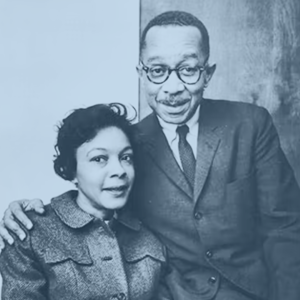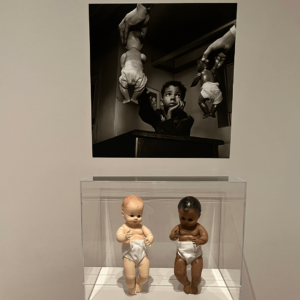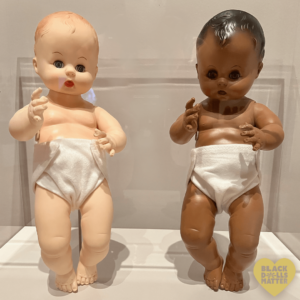
Effanbee Toy Company Twinkie dolls as seen in the Black Dolls exhibition at New York Historical Society. Photography, Black Dolls Matter®
Once upon a time, in the 1940s, two doctors named Mamie and Kenneth Clark decided to study segregation’s effects on children’s self-perception. They called this study the “doll test.”

Doctors Mamie and Kenneth Clark. (photo may be subject to copyright)
The Clarks gathered a group of African American children, between the ages of 3 and 7, from different schools in New York City. They showed each child a white doll and a black doll and asked them questions about which doll they preferred, which doll was “good” and which was “bad,” and which doll looked like them.

Gordon Parks, Untitled, New York, 1947 hangs above Effanbee Toy Company’s Twinkie dolls as seen in the Black Dolls exhibition at New York Historical Society. Photography, Black Dolls Matter®
The results of the doll test were striking. Over 75% of the children chose the white doll as their favorite and identified the black doll as “bad.” Many of the children also said that the white doll looked like them.
The Clarks concluded that segregation hurt the self-esteem and self-image of African American children and led to internalized racism. They presented their findings in court as expert witnesses in the landmark case of Brown v. Board of Education, which ultimately led to the desegregation of American schools.

They called this study the “doll test.”” width=”663″ height=”663″ /> Effanbee Toy Company Twinkie dolls as seen in the Black Dolls exhibition at New York Historical Society. Photography, Black Dolls Matter®
The Clarks’ doll test was a powerful demonstration of the harm caused by segregation, and it played an important role in the Civil Rights Movement. It showed that it’s not just about the laws but also how they affect how people see themselves. This small experiment greatly impacted how the country viewed race and segregation and helped pave the way for an equal society.
“The discrepancy between identifying one’s own color and indicating one’s color preference is too great to be ignored. The negation of the color, brown, exists in the same complexity of attitudes in which there also exists knowledge of the fact that the child himself must be identified with that which he rejects.”
– Kenneth and Mamie Clark